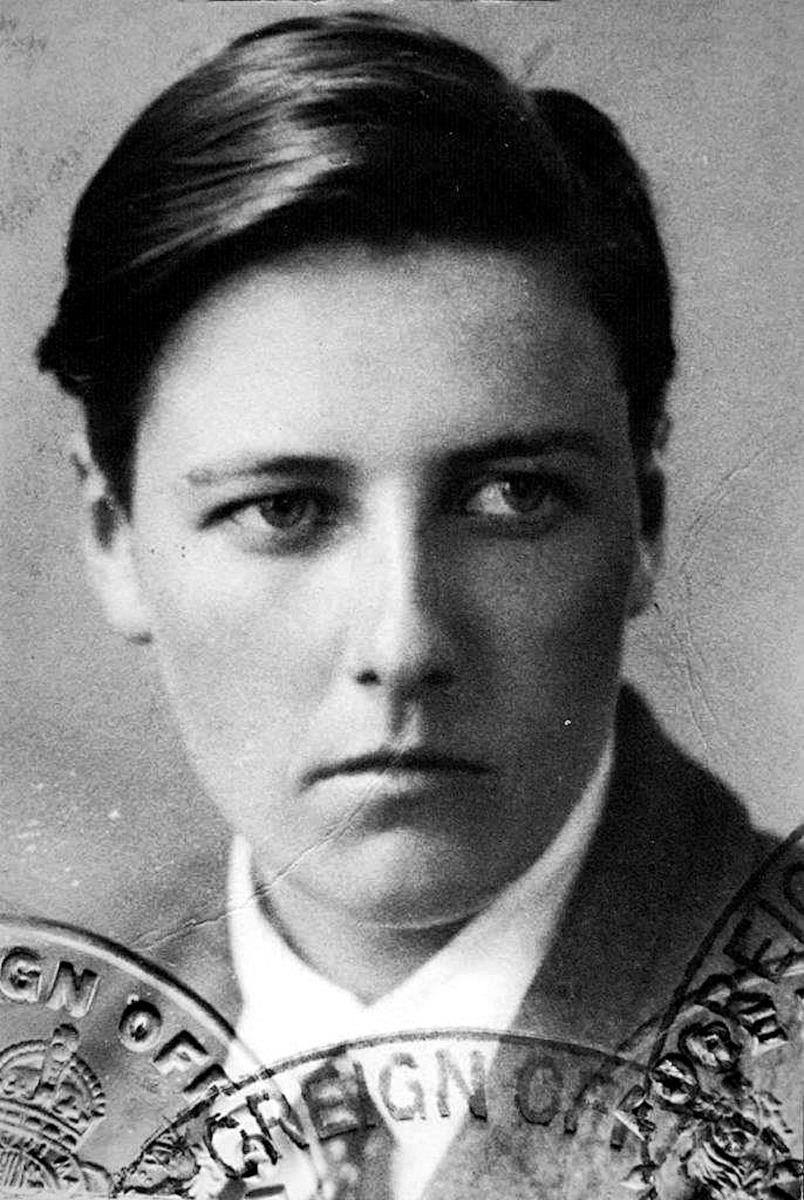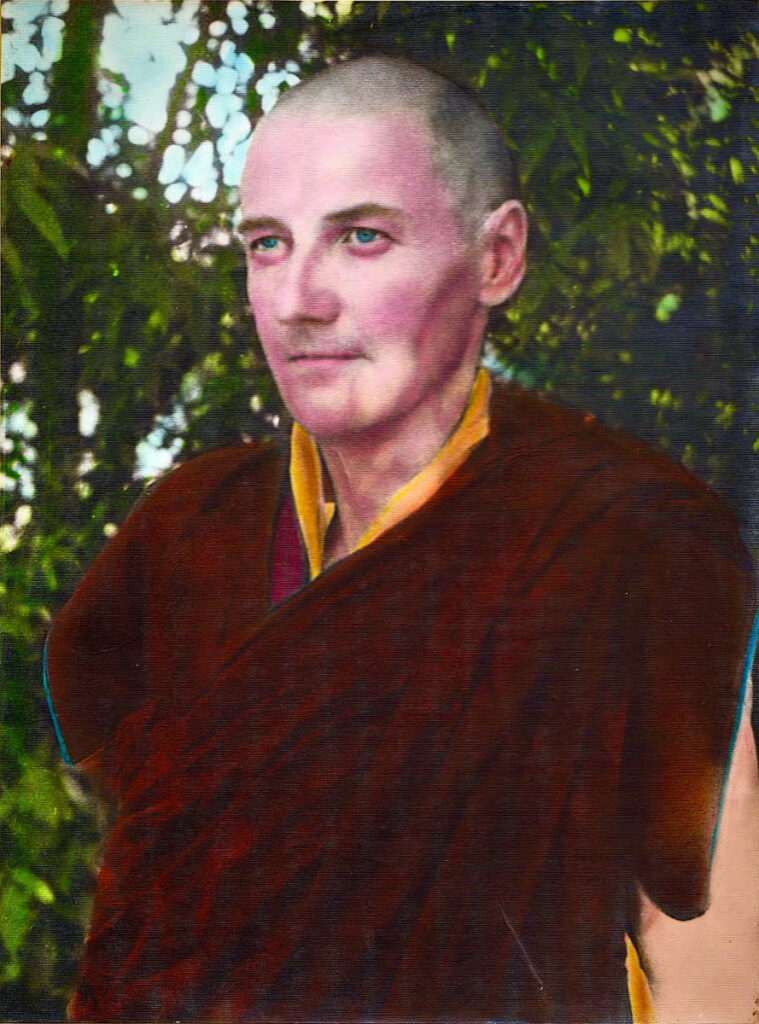

Who is
LOBZANG JIVAKA?
Warren Christopher Hallett
As World War II broke out in 1939, Lobzang Jivaka began receiving testosterone therapy.
He subsequently underwent gender-affirming surgeries – and legally registered as male. Despite being a pioneer, this trans man is not widely known. Warren Christopher Hallett attempts to change that.
One evening during LGBT+ History Month 2023, by complete happenstance, I discovered this trans pioneer. It was at Camp Books in South London. I was there to meet Brooke Palmieri (they/them), the owner-founder of this printing company. Shortly after my arrival, Brooke excused herself to finish printing some posters. I was left to potter around the office. With a mug of green tea in my hand, I made my way to the library next door to admire Brooke’s vast collection of rare books and prints.

“His name was Laurence Michael Dillon. The first British trans man who had masculinising hormone treatment (…)”
As I was walking back to the office, Brooke handed me a copy of the freshly printed poster. Eight black and white portraits stared back at me. I instantly recognised April Ashley, Sylvia Rivera and Felicia Elizondo.
“The ‘Trans Pride’ organisers from all over the UK are meeting for the first time next week at the Museum of Transology. I am going to use these posters for an icebreaker game,” Brookes explained.
My eyes were transfixed by a portrait of a very handsome bearded man, holding a pipe. His name, Lobzang Jivaka appeared beneath it. I asked Brooke if he was a trans man. What a stupid question! Of course, he was!
“His name was Laurence Michael Dillon. The first British trans man who had masculinising hormone treatment, and he was also the first to have phalloplasty.”
‘Out of the Ordinary – A Life Through Gender and Spiritual Transitions’

I promptly told Brooke that I’d google him when I got home. Sensing my interest, Brooke grabbed a book from the shelf and gave it to me entitled ‘Out of the Ordinary – A Life Through Gender and Spiritual Transitions’. The book was a memoir written by Dillon in the early 1960’s (which was eventually published in 2017).
Born on 1 May 1915 in London, Dillon was named after his mother, Laura Maude, who died from sepsis a few days after giving birth to him. His father, Robert Arthur Dillon was the heir to the seventh baronet of Lismullin had struggled with alcoholism and subsequently died of liver failure. Dillion’s father sent him and his older brother Robert to live with their aunts in Folkstone. Dillon spent his childhood there until the autumn of 1934, when he went to Oxford University to study theology.
Flash forward to 1938 when Dillion graduated from university – and a year later, World War II broke out in Europe. At the time, Dillon was hired by a research laboratory in Gloucestershire. It was there when he sought treatment for gender dysphoria from Dr George Foss and was prescribed testosterone pills. In 1942, Dillon relocated to Bristol where he met Dr Geoffrey Fitzgibbon who was responsible for his double mastectomy. This surgery, coupled with several years’ worth of hormone treatment soon made it possible for Dillon to present as a male.
Alas, it was an unrequited love…
At the age of 28, Dillon legally registered as male under the name of Laurence Michael. Following this, from 1945 to 1949, he underwent 13 phalloplasty operations, performed by his mentor Sir Harold Gillies the first of which took place as Dillon began medical school at Trinity College, Dublin. Whilst there, he authored ‘Self: A Study in Ethics and Endocrinology’, the very first book on transgender identity, advocating for medical and hormonal treatments over psychotherapy for trans people.
In 1950, a year before completing medical school, Dillon fell in love with Roberta Cowell – a trans woman on whom he performed gender-affirming surgery. Alas, it was an unrequited love as Cowell wanted their relationship to remain platonic and rejected Dillon’s romantic advances.

Broken-hearted Dillon left Dublin in 1951. He joined the British Merchant Navy as a ship’s physician, enjoying a stealth life on his voyage around the world. Cowell, on the other hand, continued to enjoy her new life as a female. She was pleased with the results of her transition, however, due to lack of work and money, in 1954 she sold her story to ‘The Picture Post’.
As the first British trans woman to have undergone gender-affirming surgery, Cowell’s story was a huge sensation propelling her to celebrity status. So famous, she even received numerous marriage proposals.
Much to Dillon’s relief, he was not implicated in Cowell’s revelation. However, it had left the press hungry for more, as they continued ferociously digging for information. In 1958, they hit the jackpot. They managed to track Dillon down and outed him. His story entitled ‘The Strange Case of Dr Dillon’ was published in ‘The Sunday Express’ (11 May) – and this was quickly followed by many articles about him in newspapers worldwide.
Without a doubt, he was a pioneer whose legacy played an important role in shaping the transgender narrative.

The unwanted press-attention led Dillon to disembark the ship in Calcutta, India and take refuge in a Buddhist monastery in Ladakh. Yet again, his life took a new direction when he became a monk and changed his name to Lobzang Jivaka. Dillon spent five years there and never returned to England. He died in Dalhousie on 15 May 1962, at the age of 47 two weeks after sending the manuscript of his autobiography to a literary agent in London.
Dillon/Jivaka’s remarkable transformative story deserves to be remembered. Without a doubt, he was a pioneer whose legacy played an important role in shaping the transgender narrative. Sadly however, many of the struggles he experienced back then have remained in the realm of trans people of today.
In his memoir, Dillon wrote, “As long as you remain as you are in yourself, you will attract the same problems, same difficulties, same situations but if you change yourself, your life will change”.
A special thanks to Brooke Palmieri of Camp Books.